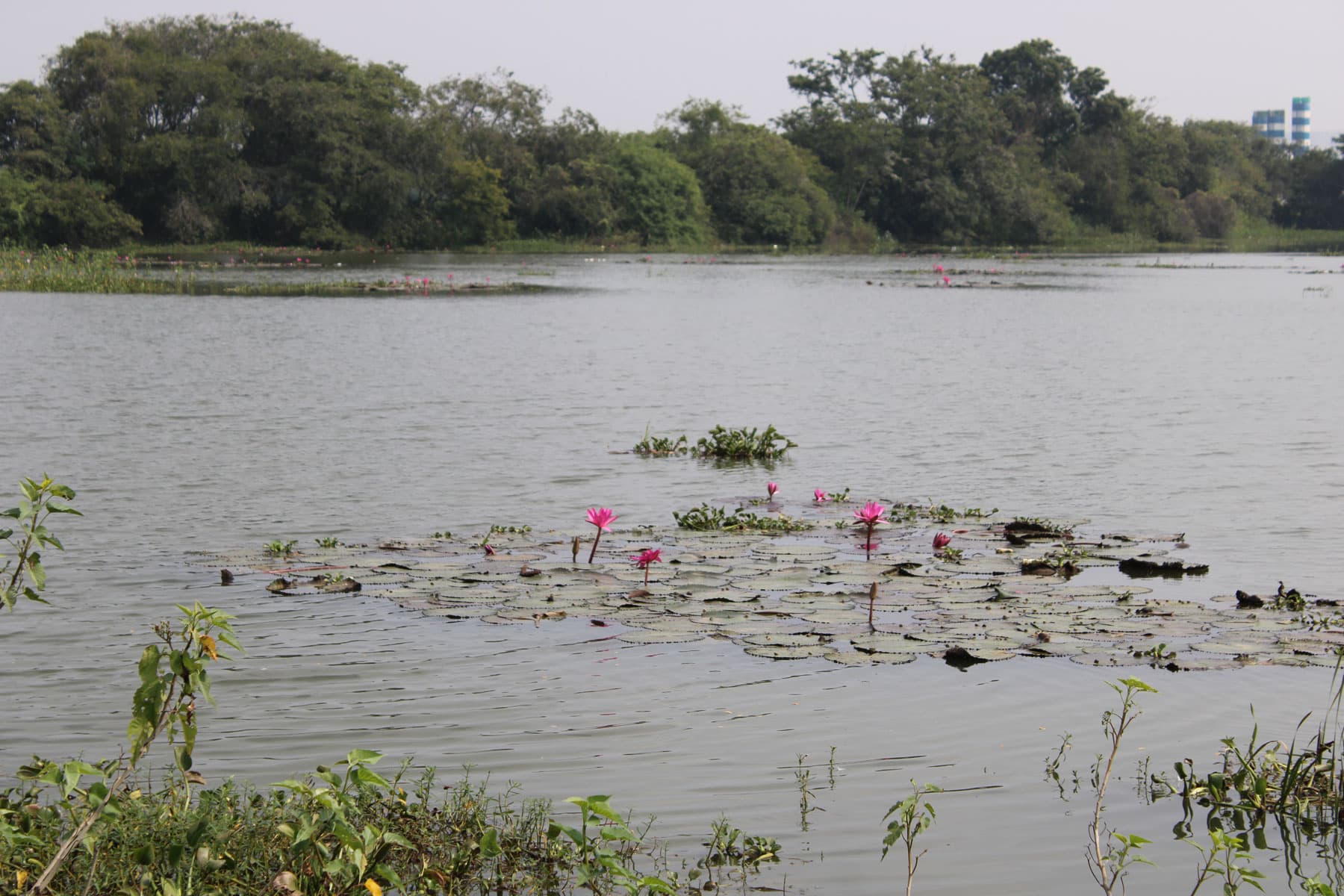
LakeRevive
Explore the ToolWhat is LakeRevive?

User-friendly scientifically backed solutions

Resource optimization

Climate resilience
Why LakeRevive is important?

Addressing the urban lake crisis

Bridging the knowledge-implementation gap

Democratising lake conservation

Supporting evidence-based policy
The tool will help generate evidence on efficacy of NbS in improving lake health. This would help in formulating evidence-based policies. To generate the evidence, communities can use lake health score card, for which the link is provided in the lake heath index page.

Preserving ecosystem services
How does it work?
Step 1: Enter basic lake parameters
Begin by entering fundamental lake characteristics from your Detailed Project Report (DPR): • Lake surface area (m²) • Average depth (m) • Water quality parameters [Total Phosphorus(TP) levels] • Area available for implementing NbS
Step 2: Enter inflow information
Provide details about the water entering your lake: • Inflow rate (KLD or m³/day) • Inflow water quality (TP levels)
Step 3: Automated analysis
The tool then processes this information through specialised algorithms that • Calculates nutrient loading rates • Determine removal requirements to achieve target water quality • Assess the feasibility of different NbS based on the available space and lake morphology
Step 4: Solution recommendation
Based on the analysis, LakeRevive provides: • A clear recommendation for either CW or FI, or a combination of both • The required size and configuration of the recommended solution • Expected nutrient removal efficiency • Alternative approaches if standard NbS are insufficient
Step 5: Implementation guidance
The tool offers practical guidance for implementing the recommended solution: • Design parameters for CW or FI • Plant species recommendations • Maintenance requirements
ಲೇಕ್ ರಿವೈವ್ ಎಂದರೇನು?

ಬಳಕೆದಾರ ಸ್ನೇಹಿ, ವೈಜ್ಞಾನಿಕವಾಗಿ ಬೆಂಬಲಿತ ಪರಿಹಾರಗಳು

ಸಂಪನ್ಮೂಲಗಳ ಸರಿಹೊಂದಿಸುವಿಕೆ

ಹವಾಮಾನ ಸ್ಥಿತಿಸ್ಥಾಪಕತ್ವ
ಲೇಕ್ ರಿವೈವ್ ಏಕೆ ಮುಖ್ಯ?

ನಗರ ಕೆರೆಗಳ ಬಿಕ್ಕಟ್ಟಿಗೆ ಪರಿಹಾರ

ಜ್ಞಾನ-ಅನುಷ್ಠಾನದ ಅಂತರವನ್ನು ಕಡಿಮೆ ಮಾಡುವುದು

ಕೆರೆ ಸಂರಕ್ಷಣೆಯನ್ನು ಪ್ರಜಾಪ್ರಭುತ್ವಗೊಳಿಸುವುದು

ಸಾಕ್ಷ್ಯ ಆಧಾರಿತ ನೀತಿಗೆ ಬೆಂಬಲ
ಈ ಉಪಕರಣವು ಕೆರೆಯ ಆರೋಗ್ಯವನ್ನು ಸುಧಾರಿಸುವಲ್ಲಿ NbSನ ಪರಿಣಾಮಕಾರಿತ್ವದ ಕುರಿತು ಸಾಕ್ಷ್ಯಗಳನ್ನು ರೂಪಿಸಲು ಸಹಾಯ ಮಾಡುತ್ತದೆ. ಇದು ಸಾಕ್ಷ್ಯ/ಪುರಾವೆ ಆಧಾರಿತ ನೀತಿಗಳನ್ನು ರೂಪಿಸಲು ಸಹಾಯ ಮಾಡುತ್ತದೆ. ಪುರಾವೆಗಳನ್ನು ರೂಪಿಸಲು ಸಮುದಾಯಗಳು ಕೆರೆಯ ಆರೋಗ್ಯ ಸ್ಕೋರ್ ಕಾರ್ಡ್ ಅನ್ನು ಬಳಸಬಹುದು. ಇದಕ್ಕಾಗಿ ಲಿಂಕ್ಅನ್ನು ಸರೋವರದ/ಕೆರೆಯ ಆರೋಗ್ಯ ಸೂಚ್ಯಂಕ ಪುಟದಲ್ಲಿ ನೀಡಲಾಗಿದೆ.

ಪರಿಸರ ವ್ಯವಸ್ಥೆಯ ಸೇವೆಗಳ ಸಂರಕ್ಷಣೆ
ಇದು ಹೇಗೆ ಕೆಲಸ ಮಾಡುತ್ತದೆ?
ಹಂತ 1: ಕೆರೆಯ ಮೂಲ ನಿಯತಾಂಕಗಳನ್ನು ನಮೂದಿಸಿ
ನಿಮ್ಮ ವಿವರವಾದ ಯೋಜನಾ ವರದಿಯಿಂದ (DPR) ಕೆರೆಯ ಮೂಲಭೂತ ಗುಣಲಕ್ಷಣಗಳನ್ನು ನಮೂದಿಸುವ ಮೂಲಕ ಪ್ರಾರಂಭಿಸಿ: • ಸರೋವರದ ಮೇಲ್ಮೈ ವಿಸ್ತೀರ್ಣ (m²) • ಸರಾಸರಿ ಆಳ (m) • ನೀರಿನ ಗುಣಮಟ್ಟದ ನಿಯತಾಂಕಗಳು [ ಒಟ್ಟು ರಂಜಕ (TP) ಮಟ್ಟಗಳು ] • NbSಅನ್ನು ಕಾರ್ಯಗತಗೊಳಿಸಲು ಲಭ್ಯವಿರುವ ಪ್ರದೇಶ
ಹಂತ 2: ಒಳಹರಿವಿನ ಮಾಹಿತಿಯನ್ನು ನಮೂದಿಸಿ
ಕೆರೆಯನ್ನು ಪ್ರವೇಶಿಸುವ ನೀರಿನ ಬಗ್ಗೆ ವಿವರಗಳನ್ನು ಒದಗಿಸಿ: • ಒಳಹರಿವಿನ ಪ್ರಮಾಣ (KLD ಅಥವಾ m³/ದಿನ) • ಒಳಹರಿವಿನ ನೀರಿನ ಗುಣಮಟ್ಟ (TP ಮಟ್ಟಗಳು)
ಹಂತ 3: ಸ್ವಯಂಚಾಲಿತ ವಿಶ್ಲೇಷಣೆ
ನಂತರ ಉಪಕರಣವು ಈ ಮಾಹಿತಿಯನ್ನು ವಿಶೇಷ ಅಲ್ಗಾರಿದಮ್ಗಳ ಮೂಲಕ ಪ್ರಕ್ರಿಯೆಗೊಳಿಸುತ್ತದೆ • ಪೋಷಕಾಂಶ ಲೋಡಿಂಗ್ ದರಗಳನ್ನು ಲೆಕ್ಕಾಚಾರ ಮಾಡುತ್ತದೆ • ಗುರಿ ನೀರಿನ ಗುಣಮಟ್ಟವನ್ನು ಸಾಧಿಸಲು ತೆಗೆದುಹಾಕುವ ಅವಶ್ಯಕತೆಗಳನ್ನು ನಿರ್ಧರಿಸುತ್ತದೆ • ಲಭ್ಯವಿರುವ ಸ್ಥಳ ಮತ್ತು ಕೆರೆಯ ರೂಪವಿಜ್ಞಾನದ ಆಧಾರದ ಮೇಲೆ ವಿಭಿನ್ನ NbSನ ಕಾರ್ಯಸಾಧ್ಯತೆಯನ್ನು ನಿರ್ಣಯಿಸುತ್ತದೆ
ಹಂತ 4: ಪರಿಹಾರದ ಶಿಫಾರಸು
ವಿಶ್ಲೇಷಣೆಯ ಆಧಾರದ ಮೇಲೆ ಲೇಕ್ ರಿವೈವ್ ಪರಿಹಾರವನ್ನು ಶಿಫಾರಸು ಮಾಡುತ್ತದೆ: • ನಿರ್ಮಿತ ಜೌಗು ಪ್ರದೇಶ (CW) ಅಥವಾ ತೇಲುವ ದ್ವೀಪಗಳು (FI) ಅಥವಾ ಎರಡರ ಸಂಯೋಜನೆಗೆ ಸ್ಪಷ್ಟ ಶಿಫಾರಸು • ಶಿಫಾರಸು ಮಾಡಿದ ಪರಿಹಾರದ ಅಗತ್ಯವಿರುವ ಗಾತ್ರ ಮತ್ತು ಸಂರಚನೆ • ನಿರೀಕ್ಷಿತ ಪೋಷಕಾಂಶ ತೆಗೆಯುವ ದಕ್ಷತೆ • ಪ್ರಮಾಣಿತ NbS ಸಾಕಷ್ಟಿಲ್ಲದಿದ್ದರೆ ಪರ್ಯಾಯ ವಿಧಾನಗಳು
ಹಂತ 5: ಅನುಷ್ಠಾನ ಮಾರ್ಗದರ್ಶನ
ಶಿಫಾರಸು ಮಾಡಿದ ಪರಿಹಾರವನ್ನು ಕಾರ್ಯಗತಗೊಳಿಸಲು ಈ ಉಪಕರಣವು ಪ್ರಾಯೋಗಿಕ ಮಾರ್ಗದರ್ಶನವನ್ನು ನೀಡುತ್ತದೆ: • ನಿರ್ಮಿತ ಜೌಗು ಪ್ರದೇಶ (CW)/ತೇಲುವ ದ್ವೀಪಗಳಿಗಾಗಿ (FI) ವಿನ್ಯಾಸ ನಿಯತಾಂಕಗಳು • ಸಸ್ಯ ಜಾತಿಗಳ ಶಿಫಾರಸುಗಳು • ನಿರ್ವಹಣೆ ಅವಶ್ಯಕತೆಗಳು





